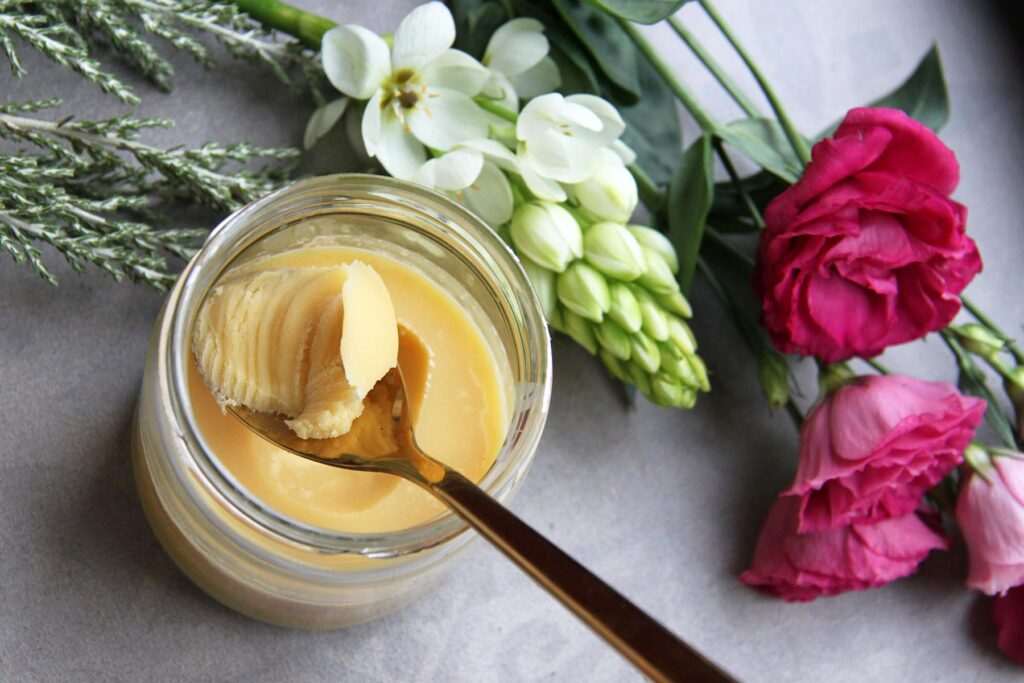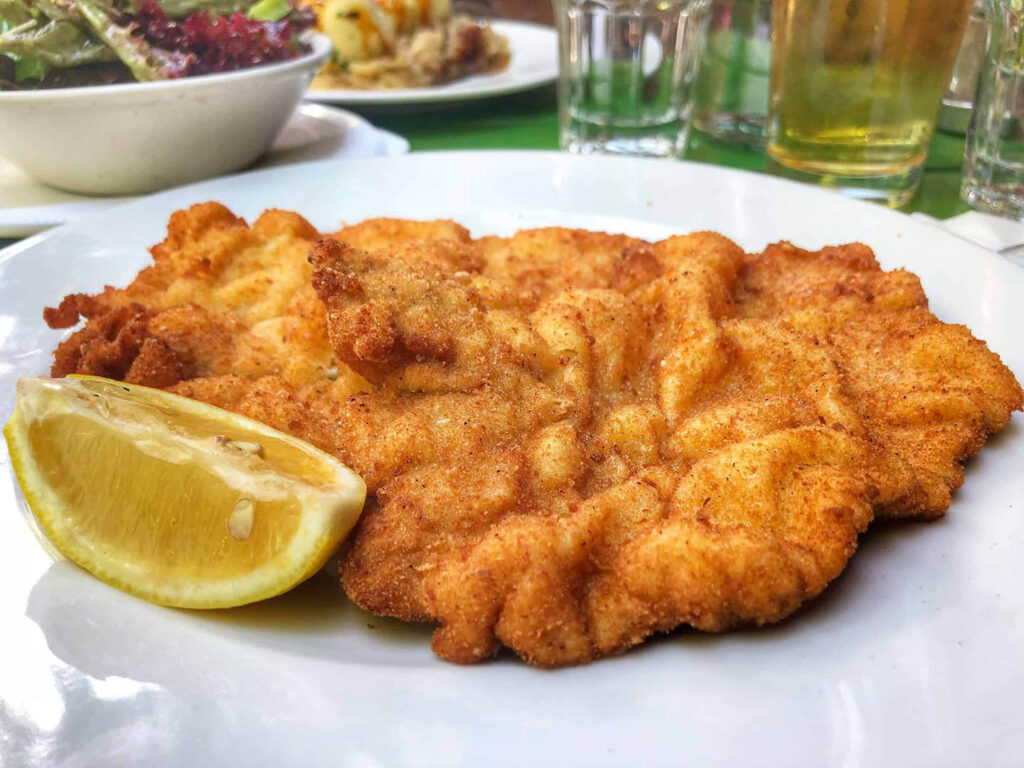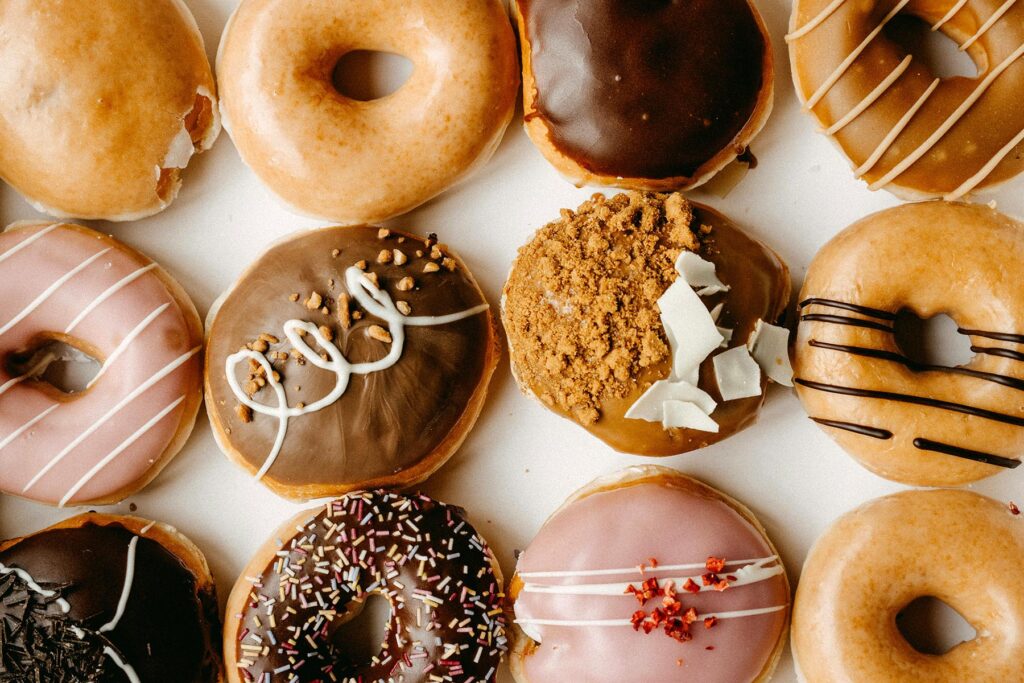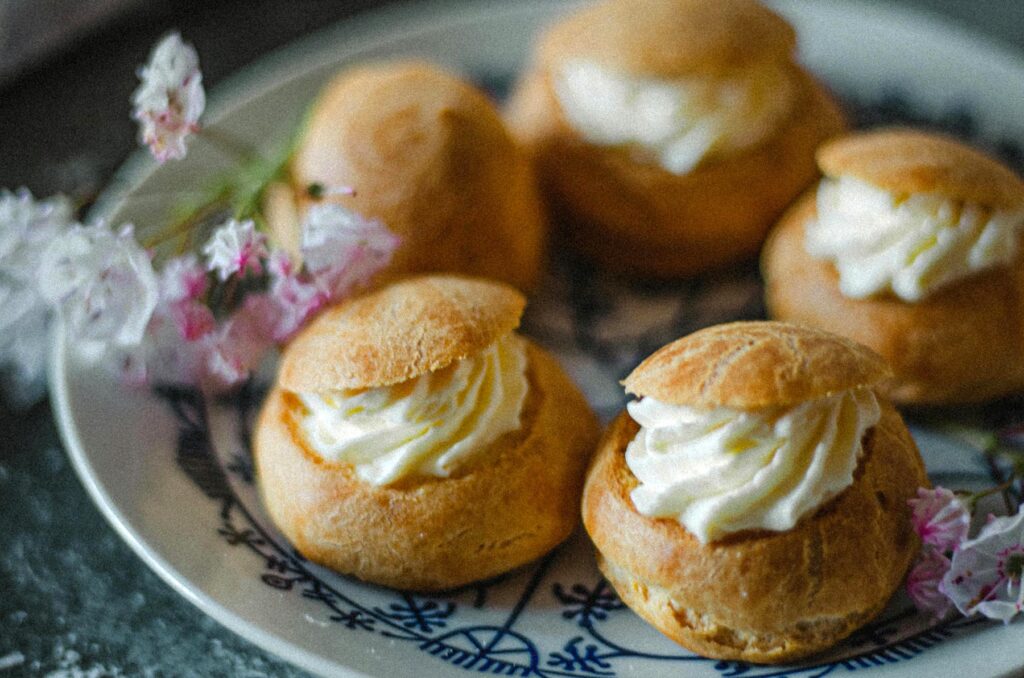
Ghee, pronounced ‘gee’ with a hard G, is a type of clarified butter that originated in ancient India and is commonly used in South Asian and Middle Eastern cuisines. Ghee does not require refrigeration and can be kept at room temperature for 3 to 6 months without spoiling. When kept at colder temperatures, ghee will solidify and can be stored for up to a year.
What is clarified butter?
Clarified butter is made by removing milk solids and water from traditional cow’s milk butter, leaving behind almost pure butterfat. Basically, the butter is heated, which evaporates the water while separating the milk solids (made of proteins and sugars); those solids settle at the bottom of the pan. The golden butterfat left at the top is carefully poured or skimmed away from the settled solids.
What is the point of clarifying butter?
Clarified butter has a higher smoke point than regular butter, making it ideal for cooking at higher temperatures without burning. It also has a longer shelf life since removing the milk solids prevents it from spoiling as quickly. Clarified butter also has a rich, buttery flavor and a smooth texture, making it a popular ingredient in cooking, baking, and frying in various cuisines worldwide, including (but not limited to) Indian, Middle Eastern, and French cuisines.
Where did ghee come from?
Ghee can be traced back thousands of years to ancient India, and mentions of it date as far back as 1500 BCE. It was a staple in culinary, medicinal, and ceremonial practices. It is believed to have been discovered as a way to preserve butter in the hot climate. By separating the milk solids from the butterfat through the process of simmering, early Indians found they could extend the shelf life of butter significantly while creating a product with a rich, nutty flavor.
Ghee quickly became an integral part of Indian cuisine, used in cooking, religious rituals, and traditional Ayurvedic (pronounced äyərˈvādik) medicine. Its high smoke point made it ideal for frying and sautéing, while its rich taste added depth to various dishes. In Hinduism, ghee is often used in religious ceremonies and offerings, symbolizing purity, prosperity, and divine blessings. As Indian culture spread throughout the world through trade and migration, so did ghee’s popularity. It became a staple ingredient not only in South Asian cuisine but also in Middle Eastern and Southeast Asian cooking.
Is ghee good for you?
In traditional Ayurvedic medicine, ghee is considered a healing food with rejuvenating properties. It is believed to balance the doshas (body energies), promote digestion, and support overall well-being when consumed as part of a balanced diet. Like other forms of clarified butter, Ghee has been associated with several potential health benefits. However, it is important to remember that ghee is very high in fat, saturated fat, and calories. Ghee can contribute to heart disease and other health issues when consumed in excess. If you have questions about incorporating foods like ghee into your diet, please seek the advice of a medical professional.
Some of the purported health benefits of consuming ghee include:
- Rich in Fat-Soluble Vitamins: Ghee is rich in fat-soluble vitamins such as vitamins A, E, and K. These vitamins play important roles in various bodily functions, including vision, immune function, and blood clotting.
- Butyric Acid Content: Ghee contains butyric acid, a short-chain fatty acid that has been associated with various health benefits. Butyric acid is thought to support gut health by nourishing the cells lining the colon and reducing inflammation in the digestive tract.
- Lactose and Casein-Free: The clarification process removes milk solids from ghee, making it suitable for individuals who are lactose intolerant or sensitive to dairy proteins like casein.
- Skin and Hair Health: Some proponents suggest that consuming ghee may benefit skin and hair health due to its nourishing properties. Ghee is also sometimes used topically as a moisturizer or in hair treatments.
How does ghee compare to butter?
Here is the basic nutritional breakdown of 1 tablespoon of ghee versus 1 tablespoon of butter:
| Ghee | Butter | |
| Calories | 123 | 102 |
| Fat | 14 grams | 11.5 grams |
| Saturated Fat | 8.7 grams | 7.2 grams |
| Monounsaturated Fat | 4 grams | 3.3 grams |
| Polyunsaturated Fat | 0.5 gram | 0.5 gram |
| Cholesterol | 35.8 milligrams | 30.5 milligrams |
| Protein | 0.4 grams | 0.1 gram |
| Vitamin A | 118 micrograms (13% DV) | 97 micrograms (11% DV) |
How do you use ghee?
Ghee has a high smoke point, which means it can be heated to higher temperatures without breaking down and producing harmful compounds. The high smoke point makes it a suitable cooking fat for frying, sautéing, and deep-frying. However, the ingredient is incredibly versatile and can be used in various culinary applications. Other than frying, sautéing, and deep-frying, ghee is often used for:
- Baking: Ghee is used to add richness and flavor to baked goods such as cookies, cakes, and bread. It can replace butter or oil in many recipes, lending a distinct nutty taste to the finished product.
- Sauces or Gravies: Ghee is an excellent base for making sauces and gravies. Its rich flavor and smooth texture help to create creamy, flavorful sauces for dishes such as curries, pasta, stir-fries, and more.
- Drizzling: Ghee can be used as a finishing touch to add richness and flavor to various dishes such as dal (lentil stew), rice, roasted vegetables, grilled meats, and more.
- Tempering: In Indian cuisine, ghee is frequently used for tempering spices. Tempering involves heating whole or ground spices in hot ghee until they release their flavors and aromas.
Are there other types of clarified butter?
There are many regional variations of clarified butter worldwide, each with its own unique flavor profile and culinary applications. Here are three other popular forms of clarified butter:
- Beurre Noisette: Beurre noisette, or brown butter, is a French variation of clarified butter. It is made by cooking butter until the milk solids turn brown, imparting a nutty flavor and aroma. Unlike traditional clarified butter, beurre noisette is cooked longer, allowing the milk solids to caramelize and develop a rich, toasty flavor.
- Niter Kibbeh: Niter Kibbeh is a type of clarified butter used in Ethiopian and Eritrean cuisines. It is seasoned with various spices such as garlic, ginger, fenugreek, cumin, and cardamom, giving it a unique flavor profile. Niter Kibbeh is often used as a cooking fat and flavoring agent in Ethiopian dishes like stews, lentils, and sautéed vegetables.
- Smoked Butter: Smoked butter is a variation of clarified butter that is infused with a smoky flavor. It is made by smoking clarified butter using wood chips or other smoking agents. The smoking process adds depth and complexity to the butter, making it a popular ingredient for adding a smoky flavor to dishes without the need for actual smoking.
Ghee continues to be cherished for its flavor, potential nutritional benefits, and cultural significance, leading to its adoption in various diets beyond traditional Indian cuisine. Its distinct aroma, rich flavor, high smoke point, and incredible versatility make it a popular ingredient worldwide.
Do you use ghee? What is your favorite way to utilize this flavorful variation of clarified butter? Let us know in the comments!



